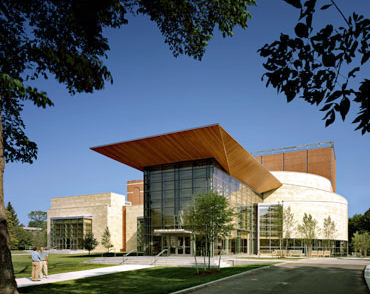Welcome to Devin Maurizio's AE Senior Thesis e-Portfolio
Reflection
AE481W/482 Course Reflection
The above-mentioned courses provide a very complete look at an entire building, from the architecture to the building integrated systems. Some house-keeping needs to be done to keep the course up to date. Most importantly, the lack of updates to the course websites made it extremely difficult to find information that was forgotten or misplaced from the handouts in class. When attempting to review the requirements for a technical assignment, a requirements sheet that is two years old is hardly helpful. In addition, the requirements for the lighting/electrical option students seem to have been produced under the ideals of what the option could be, not what it is. Electrical requirements for the project are quite lengthy, despite the fact that only two courses are offered in electrical design, and even those are minimal in nature. It's understood that senior thesis is a learning experience and the research for particular topics will be necessary, but the requirements should be based around the syllabus of the option and not some theoretical ideal. As it is, the lighting/electrical option students are asked to produce full amounts of work for two options rather than the one option that all other students are required.
I've found that the hardest part of the course is obtaining sponsorship from the architecture community. While a company that we had an internship may be able to help in ascertaining a building project, the scope of their knowledge in the project is limited and, at some point, a need will arise to contact the architect for more information. While in theory this doesn't sound difficult, it has proved that a majority of the architecture community has no time to be bothered by a student working on a project. It would be beneficial to not only the students, but the industry as well, to begin creating relations with architecture firms in a similar fashion to how the architectural engineering firms have been. By creating these relationships, students will have contacts that are willing to participate in discussions and answer questions. Generating these relationships also gives particular advantages to Penn State's architectural engineering students, as it is well known the professional relationships drive the ascertaining of business.
CPEP & Discussion Board Reflection
Maintaining a website to update, in real-time, our progress and submissions for our senior thesis was challenging on top of producing the technical documents on top of it. It seems that while this is a beneficial tool for disseminating information to the public and for the cataloging of course work for future classes, the importance placed on it's real-time visibility was probably a bit misplaced. I feel the importance of the course should have shined through on the research done and the technical assignments produced, not on how vigilant one could be in keeping a website up to date. In particular, keeping an updated progress log is impractical in nature, as it assumes that at all times, while decisions are being made, a computer is standing by to import these important happenings into the website's interface. In reality, life moves too fast for such updates to occur in a practical manner, thus leaving the information produced to be obscured by faulty short-term and, probably more often than not, long-term memories.
Having practitioners in all options available to answer real life questions over the discussion board was a very valuable asset. It gave us the opportunity to get answers to questions that we otherwise would not have been able to get. This aspect of the course resources should be strengthened in the future, adding more practitioners to the list of those available to answer questions. In fact, it could be seen that this system of intercommunication should be the foundation for a future resource in the working industry, where companies can rely on the joint knowledge of that industry to produce an overall superior product for the client.
